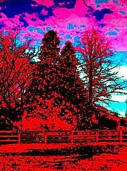
Cedar Gallery
Home
|
Cedar info |
News |
Contact |
![]() Dutch
Dutch
'Were I called on to define, very briefly, the term Art, I should call it 'the reproduction of what the Senses perceive in Nature through the veil of the soul.' The mere imitation, however accurate, of what is in Nature, entitles no man to the sacred name of 'Artist.'
Edgar Allan Poe
Artists:
Jean Dubuffet -
Lucio Fontana
-
Mariko Mori -
Bruce Nauman
- Richard Serra
-
Bill Viola
-
Ai Weiwei
Dubuffet was born in Le Havre. He moved to Paris in 1918 to study painting at the Académie Julian, but after six months he left the Académie to study independently. In 1924, doubting the value of art, he stopped painting and took over his father's business of selling wine. He took up painting again in the 1930s, when he made a large series of portraits in which he emphasized the vogues in art history. Although he stopped once more, he turned to art for good in 1942 when he started to paint figures of nude women in a impersonal and primitive way, in strong colours. Another subject he choose, was people in everyday life, such as people sitting in the underground, or just walking in the countryside. His first solo show came in 1944.
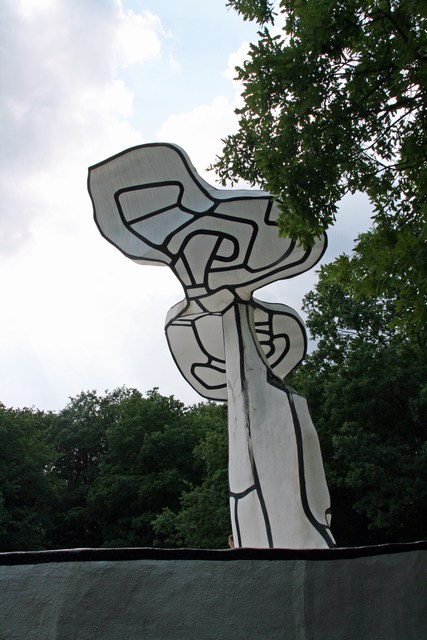
In 1945 he became strongly impressed by a show in
Paris of Jean Fautrier's paintings, in which he recognized meaningful
art which expressed directly and purely the depth of a person. Jean
Fautrier (May 16, 1898 – July 21, 1964) was a French painter and
sculptor. He was one of the most important practitioners of Tachisme*.
Just like Fautrier, Dubuffet started to use thick oil paint, but mixed
with sand and gravel, by which he could model the paint as a skin of the
painting. This resulted in the series 'Hautes Pâtes'.
After 1946 he started a series of portraits. He painted these portraits
in the same thick materials.
A few years later, in 1948, he approached the surrealist group and
became strongly connected with the artistic circle around the surrealist
André Masson. In 1944 he started an important relation with Jean Paulhan,
a French writer, literary critic and publisher.
Influenced by Hans Prinzhorn's book Artistry of the Mentally Ill, Dubuffet coined the term Art Brut (meaning "raw art," oftentimes referred to as ‘outsider art’) for art produced by non-professionals working outside aesthetic norms, such as art by psychiatric patients, prisoners, and children. He sought to create an art as free from intellectual concerns as Art Brut, and his work often appears primitive and child-like.
From 1962 he produced a series of works in which he limited himself to the colours red, white, black, and blue. Towards the end of the 1960s he turned increasingly to sculpture, producing works in polystyrene which he then painted with vinyl paint.
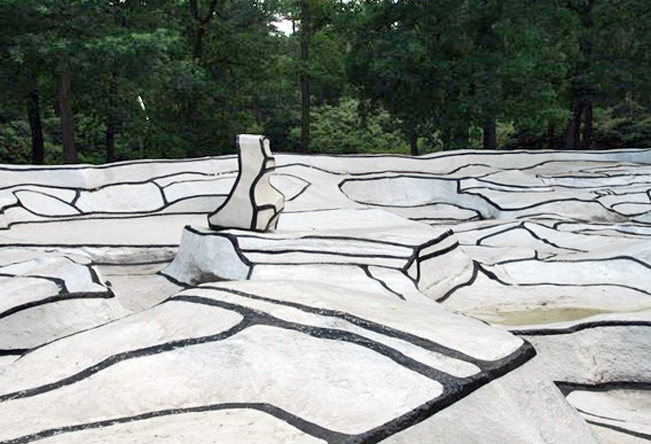
In late 1960-1961, Dubuffet began experimenting with music and sound and made several recordings with the Danish painter Asger Jorn, a founding member of the avant-garde movement COBRA. The same period he started making sculpture, but in a very not-sculptural way. As his medium he preferred to use the ordinary materials as papier mâchier and for all the light medium polystyrene, in which he could model very fast and switch easily from one work to another, as sketches on paper. At the end of the sixties he started to create his large sculpture-habitations, such as 'Tour aux figures', 'Jardin d'Hiver' and 'Villa Falbala' in which people can wander, stay, contemplate etc. In 1969 ensued an acquaintance between him and the French Outsider Art artist Jacques Soisson.
In 1973 Jean Dubuffet created a piece of art by the name ‘Jardin d’Émail’, an example of an environment. Environment art can be seen as a movement of conceptual art.
In 1978 Dubuffet collaborated with American composer and musician Jasun Martz to create the record album artwork for Martz’s avant-garde symphony entitled The Pillory.
One of Dubuffet's later works was Monument With Standing Beast (1984). Dubuffet died in Paris in 1985.
In early 2012 the Pace Gallery mounted an exhibition of work from the last two years of Dubuffet's life. Writing to Arne Glimcher, in a letter reproduced in the catalog for the exhibition, Dubuffet explained his conception for the paintings as “intended to challenge the objective nature of being. The notion of being is presented here as relative rather than irrefutable: it is merely a projection of our minds, a whim of our thinking. The mind has the right to establish being wherever it cares to and for as long as it likes. There is no intrinsic difference between being and fantasy.”
http://brooklynrail.org/2012/03/artseen/jean-dubuffet-the-last-two-years
*) Tachisme is a French style of abstract painting
popular in the 1940s and 1950s. It is often considered to be the
European equivalent to abstract expressionism.It was part of a larger
postwar movement known as Art Informel , which abandoned
geometric abstraction in favour of a more intuitive form of expression,
similar to action painting. Another name for Tachism is Abstraction
lyrique (related to American Lyrical Abstraction). COBRA is also
related to Tachisme, as is Japan's Gutai group.
Artists you may think of are Pierre Alechinsky, Karel Appel, Alberto Burri, Jean Fautrier, Lucio Fontana, Sam Francis, Asger Jorn, Jackson Pollock and Zao Wou Ki. And others, of course…
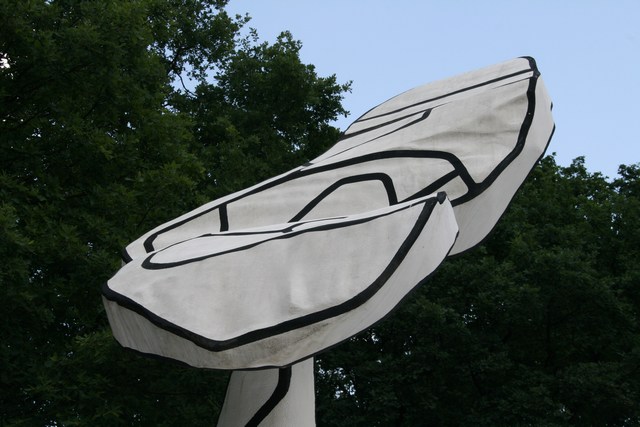
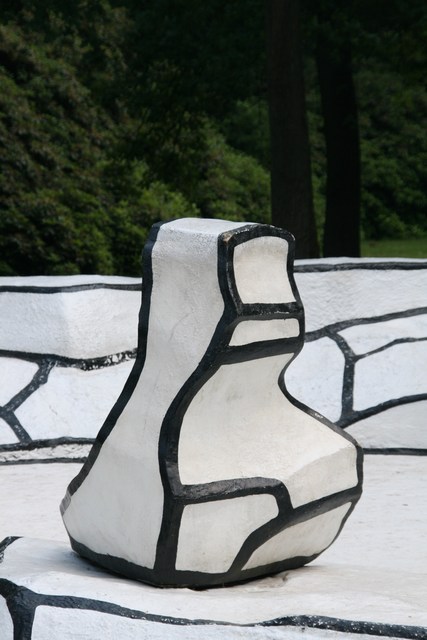
© pictures: wagenvoorde
Sculpture Garden, Kröller Müller Museum, Holland
Lucio Fontana (19 February 1899 – 7 September 1968) was an Italian painter, sculptor and theorist of Argentine birth. He was mostly known as the founder of Spatialism and for his ties to Arte Povera.
Fontana spent the first years of his life in Italy and came back to Argentina in 1905, where he stayed until 1922, working as a sculptor along with his father, and later on his own. As early as 1926 he participated in an exhibition.
In 1927 Fontana returned to Italy and studied under
the sculptor Adolfo Wildt, at Accademia di Brera from 1928 to
1930. (Having a strong late nineteenth century Romanticism background,
Wildt is dedicated to the art of sculpture, strongly influenced by the
Secession and by Art Nouveau. It is characterized by
complex symbolism and by definition is almost gothic in its forms.)
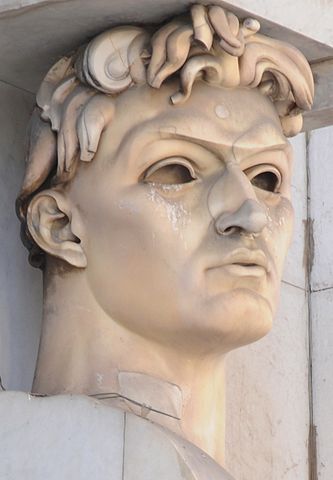
Damiano Chiesa, by Adolfo Wildt ©
wolfgang moroder
It was there where Fontana presented his first exhibition in 1930. During the following decade he travelled through Italy and France, working with abstract and expressionist painters. In 1935 he joined the association Abstraction-Création in Paris and from 1936 to 1949 made expressionist sculptures in ceramic and bronze. In 1939, he joined the Corrente, a Milan group of expressionist artists.
In 1940 he returned to Argentina. In Buenos Aires (1946) he founded the Altamira academy together with some of his students. The White Manifesto was published, where is stated that "Matter, colour and sound in motion are the phenomena whose simultaneous development makes up the new art". In the text, which Fontana did not sign but to which he actively contributed, he began to formulate the theories that he was to expand as Spazialismo, or Spatialism, in five manifestos from 1947 to 1952
Following his return to Italy in 1948 Fontana exhibited his first Ambiente spaziale a luce nera (Spatial Environment) (1949) at the Galleria del Naviglio in Milan, a temporary installation consisting of a giant amoeba-like shape suspended in the void in a darkened room and lit by neon light. From 1949 on he started the so-called Spatial Concept or slash series, consisting in holes or slashes on the surface of monochrome paintings, drawing a sign of what he named "an art for the Space Age".
Fontana often lined the reverse of his canvases with black gauze so that the darkness would shimmer behind the open cuts and create a mysterious sense of illusion and depth. He then created an elaborate neon ceiling called "Luce spaziale" in 1951 for the Triennale in Milan. In his important series of Concetto spaziale, La Fine di Dio (1963–64), Fontana used the egg shape.
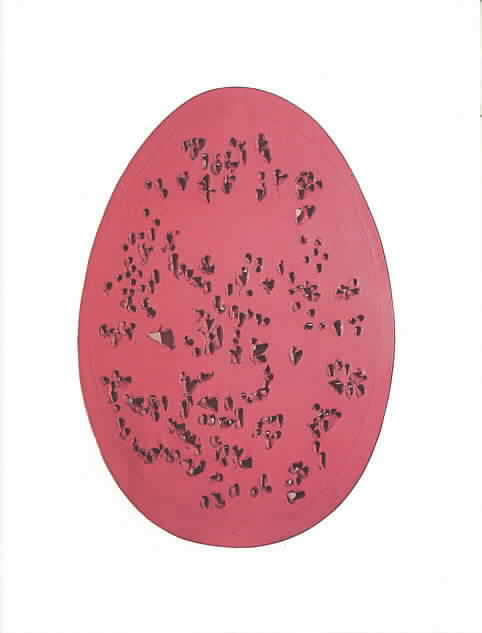
The End of God
The End of God (1963)
A pink, egg-shaped canvas is peppered with numerous clusters of puncture marks, revealing the blank space behind. This is one of the series of works in which Fontana made single cuts or holes in the canvas, and represents the artist’s ultimate gestural act. The puncture marks and gashes were made to draw attention to the infinite space behind the canvas, making the void beyond the flat surface as much a part of the work as the canvas itself.
This rejection of the traditional space of the canvas, and the movement of the work into the real space of the gallery is typical of Spazialismo.
Fontana engaged in many collaborative projects with the most important architects of the day, in particular with Luciano Baldessari, who shared and supported his research for Spatial Light – Structure in Neon (1951) at the 9th Triennale and, among other things, commissioned him to design the ceiling of the cinema in the Sidercomit Pavilion at the 21st Milan Fair in 1953.
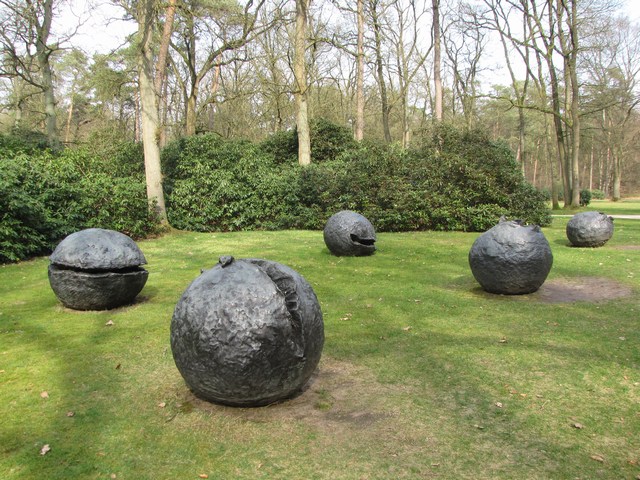
Concetto Spaziale 'Natura', 1959-1960
Around 1960, Fontana began to reinvent the cuts and
punctures that had characterized his highly personal style up to that
point, covering canvases with layers of thick oil paint applied by hand
and brush and using a scalpel or Stanley knife to create great fissures
in their surface. In 1961, following an invitation to participate along
with artists Jean Dubuffet, Mark Rothko, Sam Francis, and others in an
exhibition of contemporary painting entitled "Art and Contemplation",
held at Palazzo Grassi in Venice, he created a series of 22 works
dedicated to the lagoon city. He manipulated the paint with his fingers
and various instruments to make furrows, sometimes including scattered
fragments of Murano glass
Among Fontana’s last works are a series of Teatrini (‘little theatres’),
in which he returned to an essentially flat idiom by using backcloths
enclosed within wings resembling a frame; the reference to theatre
emphasizes the act of looking, while in the foreground a series of
irregular spheres or oscillating, wavy silhouettes creates a lively
shadow play
In the last years of his career, Fontana became increasingly interested in the staging of his work in the many exhibitions that honored him worldwide, as well as in the idea of purity achieved in his last white canvases. These concerns were prominent at the 1966 Venice Biennale, for which he designed the environment for his work. At Documenta IV in Kassel in 1968, he positioned a large, revelatory slash as the centre of a totally white room (Ambiente spaziale bianco).
Shortly before his death he was present at the "Destruction Art, Destroy to Create" demonstration at the Finch College Museum of New York. Then he left his home in Milano and went to Comabbio (in the province of Varese, Italy), his family's mother town, where he died in 1968.
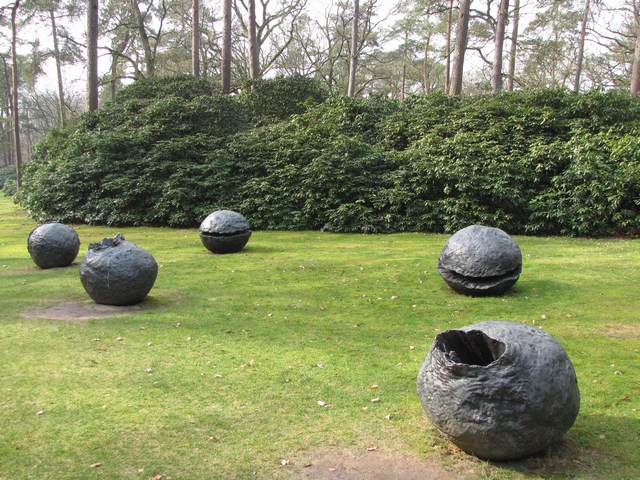
Fontana had his first solo exhibitions at Galleria
del Milione, Milan, in 1931. In 1961, Michel Tapié organized his first
show in the U.S., an exhibition of the Venice series, at the Martha
Jackson Gallery, New York. He participated in numerous exhibitions
around the world.
Today Fontana's works can be found in the permanent collections of more
than one hundred museums around the world. In particular, examples from
the Pietre series are housed in the Stedelijk Museum, Amsterdam, the
Centre Pompidou, Paris, the Galleria Nazionale d'Arte Moderna, Rome, and
the van Abbemuseum, Eindhoven. Fontana's jewelry is included in the
permanent collection of the Museum of Fine Arts, Boston.
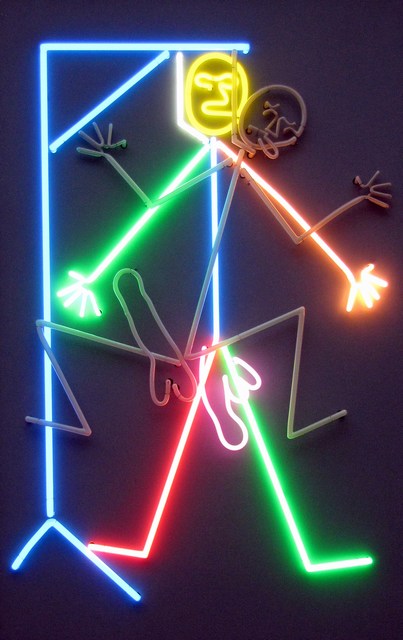
Bruce Nauman, born in 1941 in Fort Wayne, Indiana, has been recognized
since the early 1970s as one of the most innovative and provocative of
America's contemporary artists. After leaving school, Nauman had the
simple realization that, if he was an artist and if he was in the
studio, that whatever he was doing in the studio must be art.
Early on, he abandoned painting and began a restless investigation into
the possibilities of sculpture, performance, installations, film ,
video, photography and neon for his work. Ideas from other disciplines,
like literature, dance, music and theatre were to play an increasingly
important role in his art.
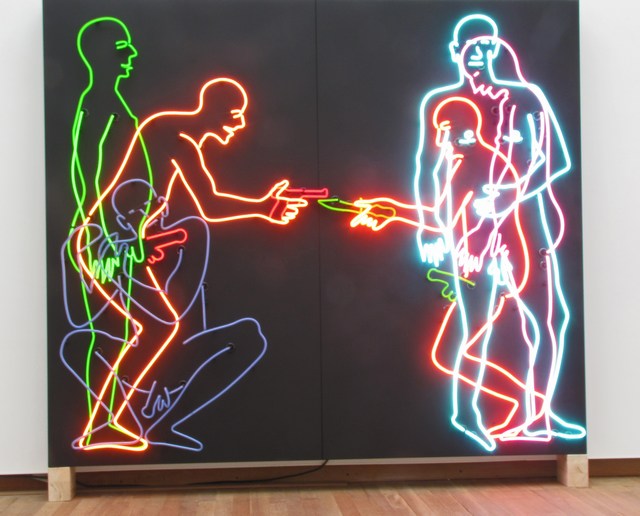
Sex and death, 1985
Nauman was a pioneer in the field of video art. The series of early
videos from the 1960s, in which he filmed himself carrying out absurd
and pointless exercises in his studio, are considered particularly
ground-breaking.
He has never imposed any limitations on himself.
For the neons, Bruce Nauman made sketches in pencil, charcoal and
watercolour. For the figures, he used the outlines of the bodies of
himself and his wife. The double outlines in different colours indicate
where neon is to be used, and the layered figures indicate how they will
appear when the neon flashes on and off. The primary colours red, yellow
and blue are used for the male figures, while the female figures are
represented in softer shades like pink, green and orange. The timing of
the sequences is very important and is fixed and repeated in a continual
loop, each figure having its own individual programme.

Live and Die, 1983 (Herbert Foundation)
Though neon light is immaterial, it draws attention immediately,
completely dominating its environment and attracting through its warm
glow and intense colours.
...
Conflicting signals are given simultaneously in a deliberate attempt to
arouse confusion and unease in the viewer.
In 2009, Bruce Nauman was awarded the oeuvre prize, the Golden Lion, at
the Venice Biennale.
I met with the art of Bruce Nauman at the Benesse House Museum, in
Japan. I saw the installation '100 Live and Die', a neon billboard of
flashing phrases, and was intrigued. I went back in the evening, when
there was no one around and everything dark, except this installation.
Guests of the hotel are permitted to wander beyond closing time. It was
fascinating. This dark, concrete gallery, and 'CRY AND LIVE', and/or 'THINK
AND DIE', it read, in large, glowing letters.
'SMILE AND LIVE'.
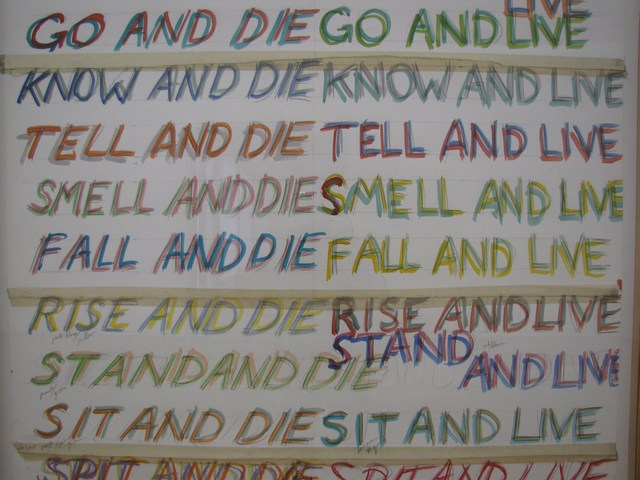
A remarkable place to be, on the tiny island of Naoshima in the Seto
Inland Sea of southern Japan. A place where art and nature go hand in
hand.
(The construction of the Benesse House Museum in 1992
marked the beginning of a fruitful partnership between Benesse
Corporation and another Pritzker winner, the Japanese architect
Tadao Ando.
To date, he has designed seven structures on the small island, including
three museums and the Benesse House Park building, which is studded with
museum-worthy pieces.)
Unfortunately taking pictures of '100 Live and Die' was not allowed at
this beautiful place, so I can't show you the glowing letters here.
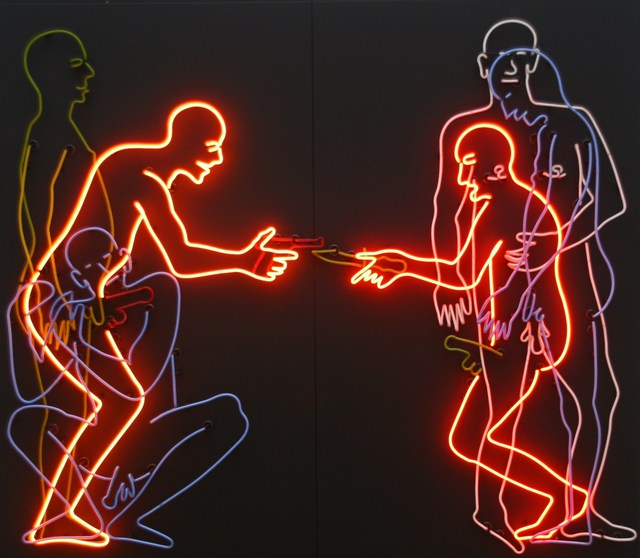
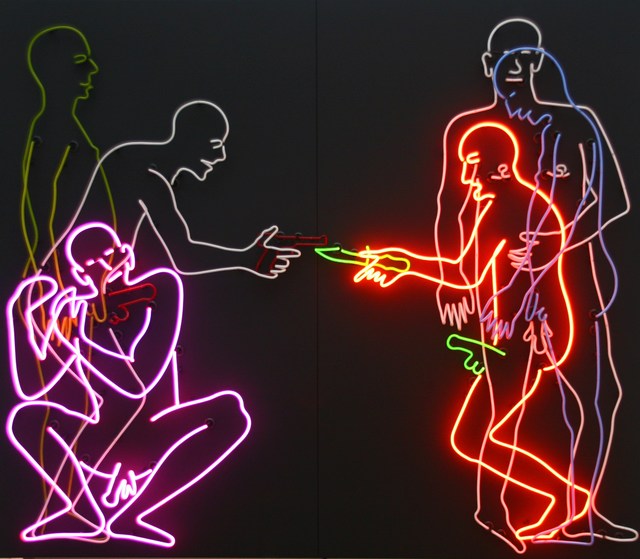
Sex and death, 1985
The works shown here are of an exhibition in
the Bonnefantenmuseum in Maastricht, Holland.
Works by Bruce Nauman in the Bonnefantenmuseum's coleection include a
series of works on paper, and an installation from 1990, Hand Puppet.
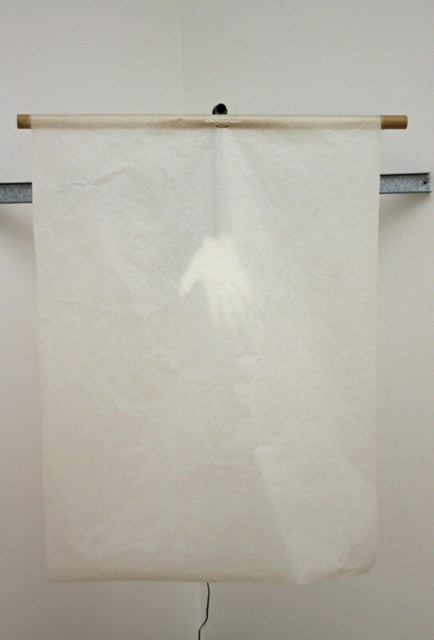
Hand Puppet, 1990
Bill Viola, Flushing, New York, 1951
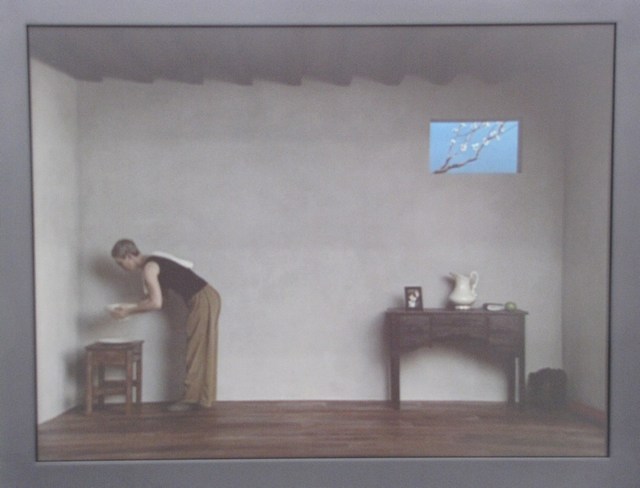
Catherine’s Room 2001
Color video on five LCD flat panels
Originally from New York, Viola has travelled widely. He studied Zen meditation and advanced video technology during a period of 18 months in Japan, before moving to southern California at the beginning of the 1980s. His experience of Eastern philosophy has informed his artistic investigation into the relationship between an individual's inner life and the experience of his body. In his work with experimental sound and video he therefore aims to create art which operates as a complete 'experience'.
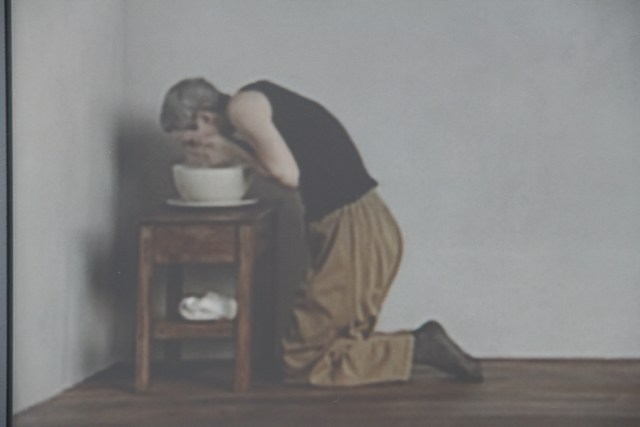
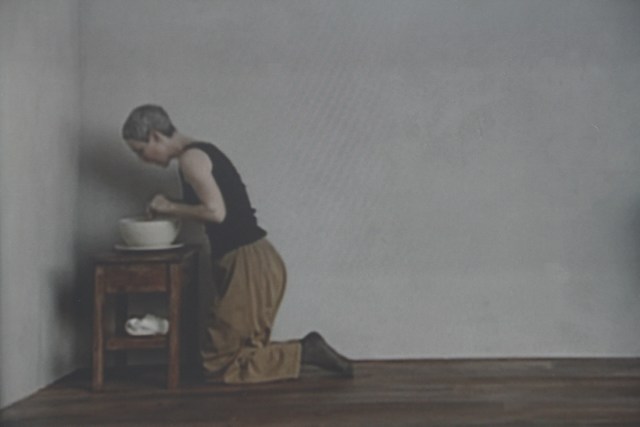
The video artist Bill Viola takes inspiration from
painterly traditions. That influence can be discerned both in his choice
of subject matter and in his manner of portrayal. The five LCD screens
that make up Catherine’s Room remind one of a traditional polyptych,
which was used as an altarpiece since the late Middle Ages. The title of
this work could refer to St. Catherine, who led a life of spirituality
and ascetism. Despite associations with ancient paintings, the woman
herself has a thoroughly contemporary appearance.
The incidence of light shows that we are seeing the room at five
different times of the day, and the branch of a tree, visible through a
window in the back wall, reveals the change of seasons. Viola seems to
decelerate the passing of time. Actions and movements thereby acquire a
magnified expressiveness and a ritual quality. And as is often the case
in Viola’s work, the cyclical movement of time is conveyed.
The Tate Gallery in London has a work of him, titled
‘Nantes Triptych (1992).
This work consists of three, large-scale panels of projected video
images. On the left a young woman is giving birth, while on the right an
old woman is dying.
Both are recordings of real events. For more information and pictures:
http://www.tate.org.uk/art/artworks/viola-nantes-triptych-t06854
In the centre, a naked figure is submerged under water, floating,
sometimes still and then moving in a turbulent manner, as if drowning.
Birth and death are a continuum, while, in the meantime, we experience
the chaos of our lives.
Viola is influenced by his travels, studying local religions, and
investigating different cultural responses to man’s relationship with
nature and other universal questions of existence.
Catherine’s Room (2001)
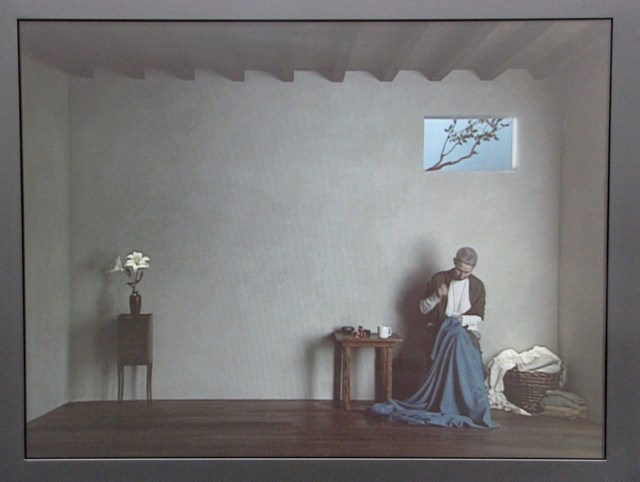
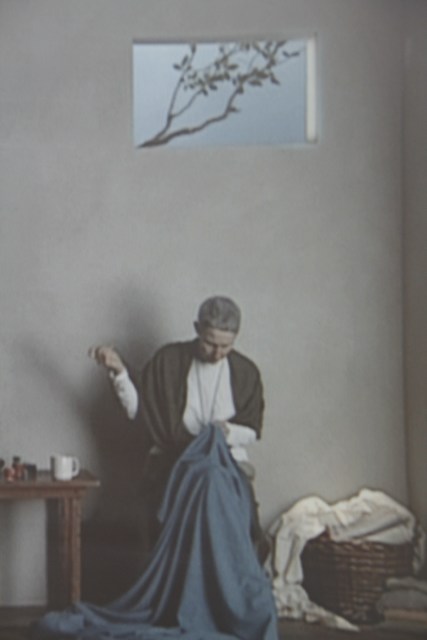
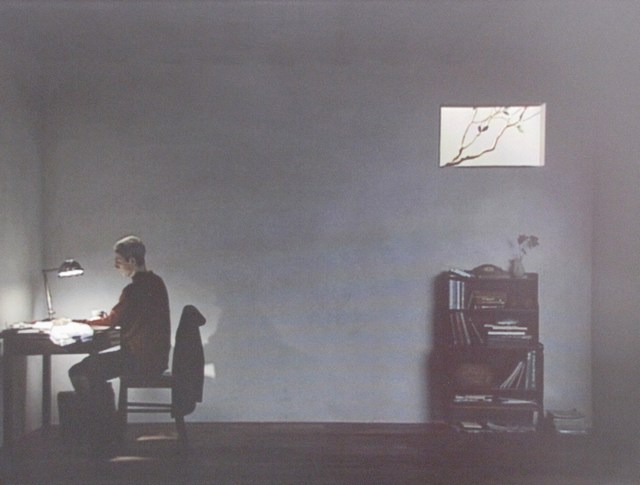

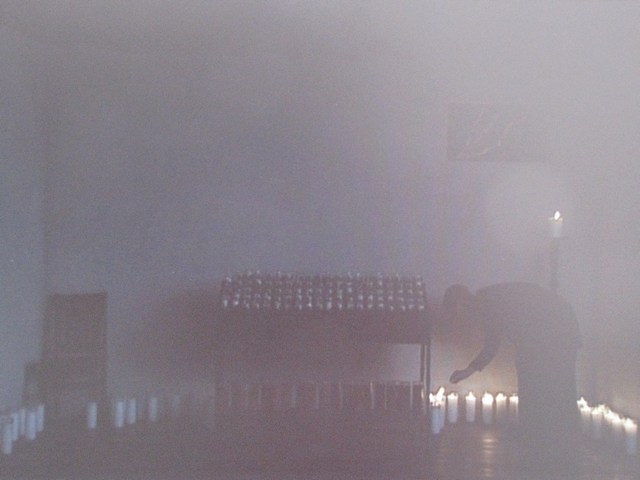
© pictures: wagenvoorde
Tilburg 2012
http://www.depont.nl/en/collection/artists/artist/kunstenaar/viola/werk/
Richard Serra (born November 2, 1939) is an American
minimalist sculptor and video artist known for working with large-scale
assemblies of sheet metal. Serra was involved in the Process
Art Movement.
Process art is an artistic movement as well as a
creative sentiment where the end product of art and craft, the objet
d’art, is not the principal focus. The 'process' in process art refers
to the process of the formation of art: the gathering, sorting,
collating, associating, patterning, and moreover the initiation of
actions and proceedings. Process art is concerned with the actual doing
and how actions can be defined as an actual work of art; seeing the art
as pure human expression.
Some artists who were involved in this movement as well, are:
Lynda Benglis, Eva Hesse,
Bruce Nauman and Robert Morris.

Sea Level
Richard Serra was born in San Francisco. His father,
Tony, was Spanish native of Mallorca and his mother, Gladys, was Russian
from Odessa. Serra studied English literature at the University of
California, Berkeley and later at the University of California, Santa
Barbara between 1957 and 1961. While at Santa Barbara, he studied art
with Howard Warshaw and Rico Lebrun. On the West Coast, he supported
himself by working in steel mills, which turned out to have a strong
influence on his later work.
Serra discussed his early life and influences in an interview in 1993.
He described the San Francisco shipyard where his father worked as a
pipe-fitter as another important influence on his work, saying of his
early memory: “All the raw material that I needed is contained in the
reserve of this memory which has become a reoccurring dream.”
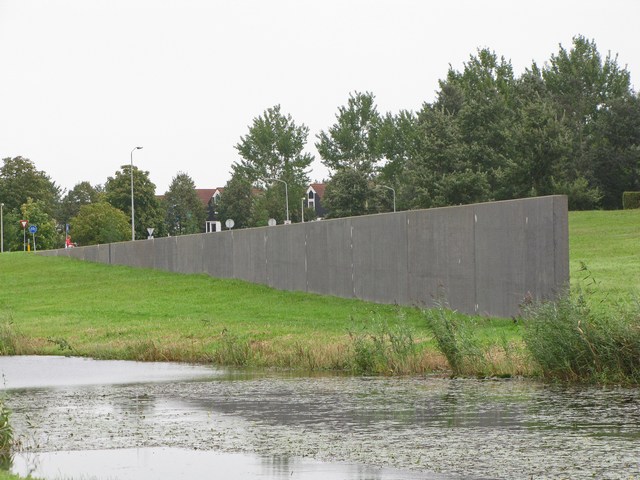
Serra started living in New York in the 1960s, and there his circle of friends included Carl Andre, Walter De Maria, Eva Hesse, Sol LeWitt, and Robert Smithson.
Information about his life and work can be found here: http://en.wikipedia.org/wiki/Richard_Serra
Serra's drawings are not sketches for his sculptures, but autonomous works of art. Although he has been drawing since 1972, his first solo exhibition only came in 1974, in New York. The pictures below are taken at an exhibition in the Bonnefantenmuseum in Holland, in 2011.
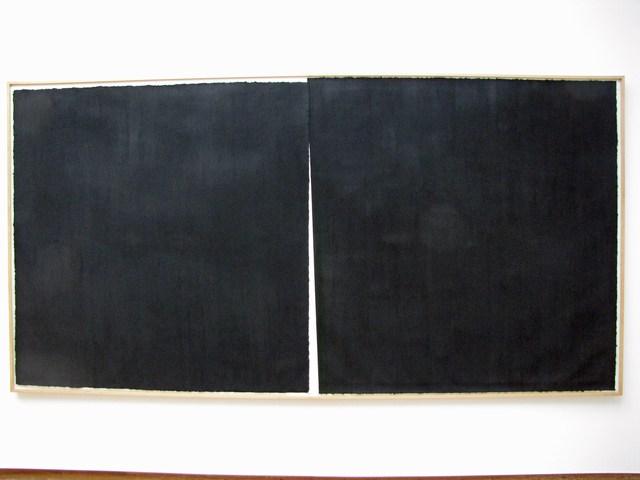
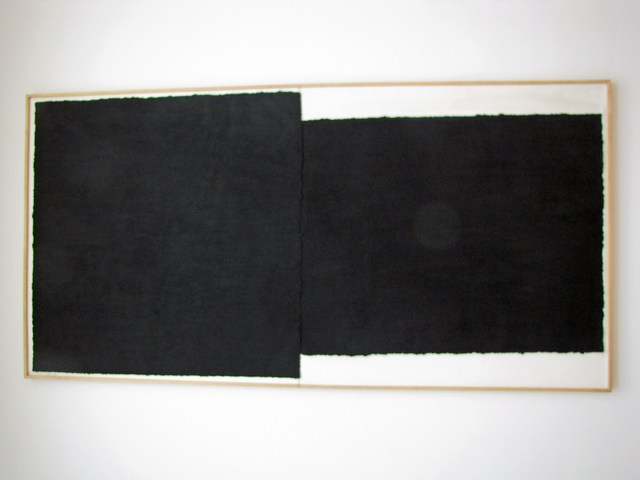
‘I like to draw. It is an activity I
rely on, a dependency of sorts. Drawing gives me an immediate return for
my effort and the result is commensurate with my involvement. It is an
activity that requires solitude, it is the most concentrated space in
which I work.’
Richard Serra 1971
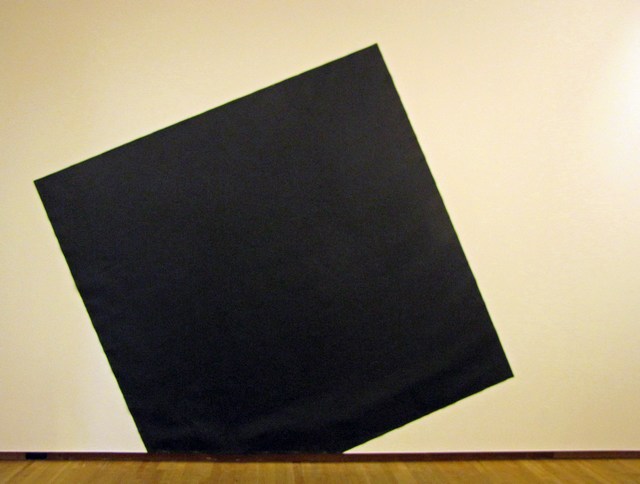
‘There is no way to
make a drawing – there is only drawing. ‘
Richard Serra 1977
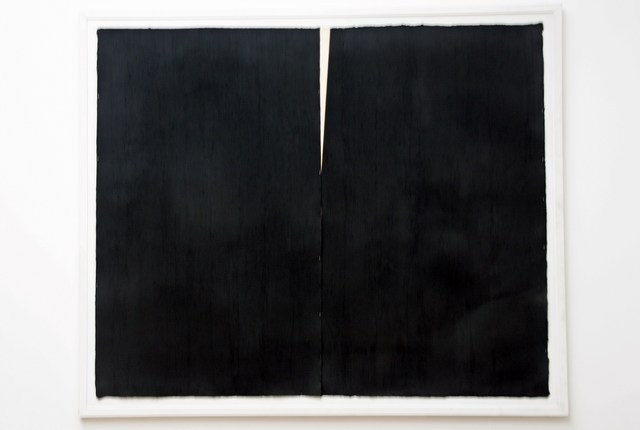
‘I am aware that people call my black drawing installations sculptural. Not only are these drawings flat and flush with the wall, but they do not create any illusion of three-dimensionality. They do, however, involve the viewer with the specific three-dimensionality of the site of the installation.’
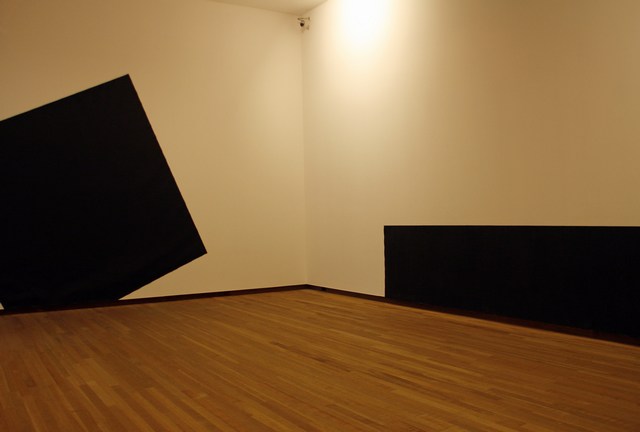
To use black is the clearest way of marking against a
white field, no matter whether you use lead or charcoal or paint stick.
It is also the clearest way of marking without creating associative
meanings…
A canvas covered with black remains an extension of drawing in that it
is an extension of marking.’
Richard Serra Drawings Zeichnungen
1969-1990, Notes on Drawing p.11, Bentelli AG. Bern, 1990
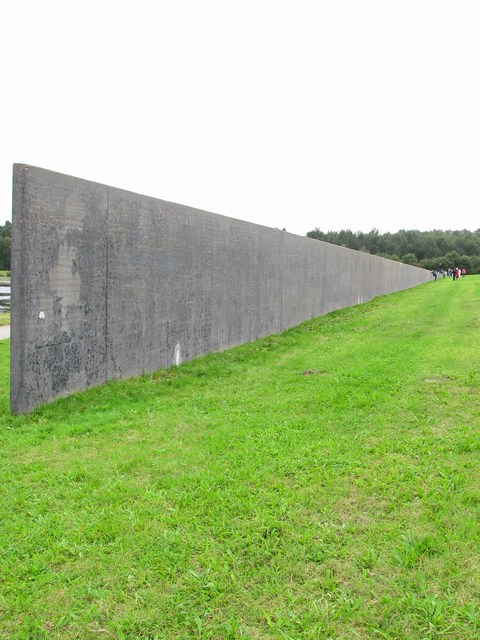

Site-specific art is artwork created to exist in a
certain place. Typically, the artist takes the location into account
while planning and creating the artwork.
A nice example of this is Sea Level.
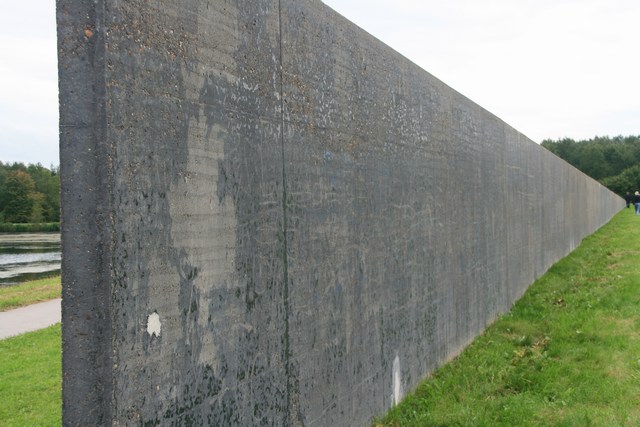
With two 200-metre long walls and the grass and water
in between, Sea Level is Serra's largest work in Europe. If you walk
along the wall, the artwork gives you the feeling of being submerged
under water while slowly floating back tot the surface a little further
on.
When visiting Zeewolde, Serra was fascinated by the fact that the
village lies below the surrounding lakes of Wolderwijd and Nuldernauw.
Sea Level signifies the physical meaning of the notion of the sea level:
without the dikes, the water would reach the top of the artwork. Thus,
Sea Level reminds us of the creation of Zeewolde on the bottom of the
former Zuiderzee.
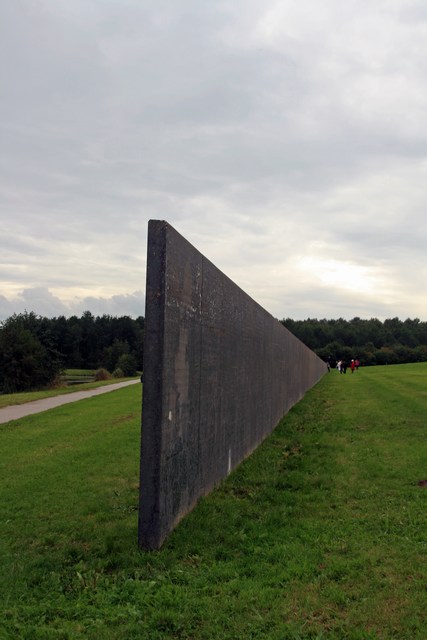
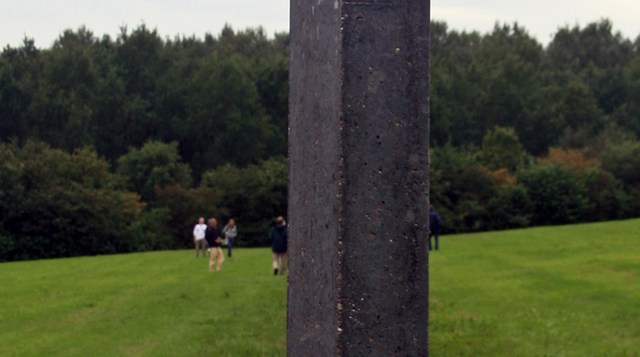
Depending on the weather conditions, the massive walls will undergo a transformation. On a sunny day the blue sky will be reflected by the shiny silvery wall, whereas on heavily clouded days the wall will take on a dark grey colour and look impenetrable.
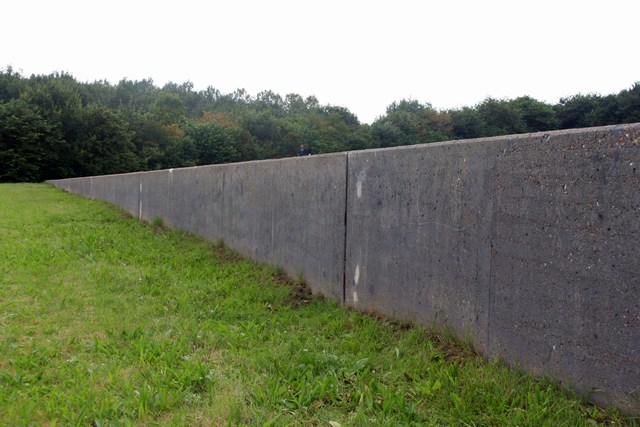

Sea Level by Richard Serra, exhibited in Zeewolde, Holland.
Photos © wagenvoorde
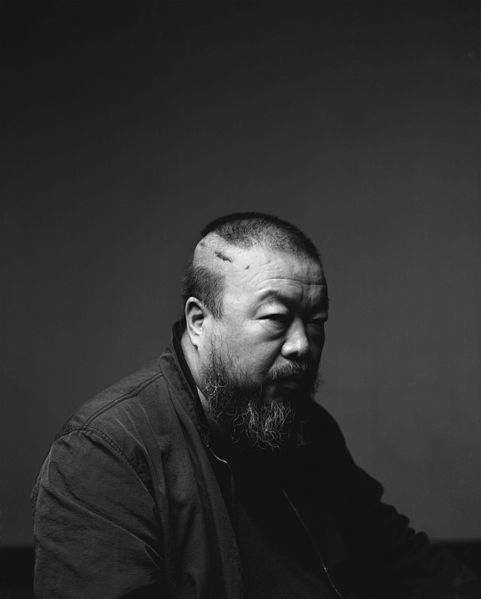
Ai Weiwei (picture: Gao Yuan)
Ai Weiwei (1957)
‘Since his emergence as an artist in the late 1970s.
Ai Weiwei has been a prime mover in the Beijing art scene, combining his
roles as artist, architect, and instigator to create new institutions as
well as new art forms.
……
Ai Weiwei grew up well aware of the irrationality of political movements
and social upheavals.
His family returned to Beijing in 1978, where he attended the Beijing
Film Institute and helped organize ‘The Star’ group, the first artist
collective to present avant-garde art in China.
In 1981, he moved to the United States, where he immersed himself in
experimental art movements, from Dadaism and Fluxus through Andy Warhol
and the East Village scene, beginning to incorporate these ideas into
his work.’
(From:
China Art Book, Ai Weiwei)
When Ai Weiwei returned to China, in 1993, he soon
became a central figure in Beijing’s East Village.
In 2000, on the occasion of the Shanghai Biennial, Ai Weiwei arranged
‘Fuck Off!’, with critical and disturbing art works.
By then he was gaining international attention for his own art works
which meld a Dada sensibility with traditional Chinese antiquities and
craftsmanship.
Ai Weiwei is active in sculpture, installation, architecture,
photography, film, and social, political and cultural criticism. Ai
collaborated with Swiss architects Herzog & de Meuron as the artistic
consultant on the Beijing National Stadium for the 2008 Olympics.
As a political activist, he has been highly and openly critical of the
Chinese Government's stance on democracy and human rights.

Hanging Man In Porcelain 2011
Ai Weiwei’s first one-man show, in New York in 1988
included a portrait of Marcel Duchamp, consisting of a wire hanger
twisted into a silhouette of this French-American artist who, along with
Andy Warhol, is one of Ai’s greatest idols.
Duchamp is best known for his use of ‘readymades’ – everyday objects
introduced into an art context. In Hanging Man in Porcelain Ai
refers back to his earlier work, but he adds another dimension to the
updated Duchamp portrait by executing it in porcelain, a material that
is generally associated with delicacy and fragility. Here, though, it is
also the concrete material of Duchamps famous Fountain, a porcelain
urinal that Duchamp adorned with a fake signature (R. Mutt) and
submitted to the Armory shows in 1917.
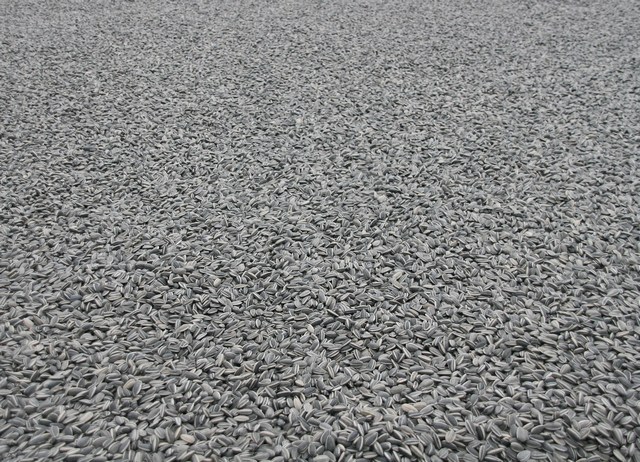
5000 kg Sunflower Seeds 2010
Sunflower Seeds is made up of millions of small sculptures, apparently identical, but each one actually sculpted and painted. These are two smaller versions of the work which, on having its debut in Tate Modern in 2010, made Ai Weiwei known to a wider audience.

To the Chinese people, sunflower seeds have various connotations. Not
only do they serve as food: during the Cultural Revolution, they
acquired symbolic meaning as well. Once Chairman Mao had appropriated
the sun as his personal symbol, the Chinese people were compared to
sunflowers, which looked up in admiration at The Great Helmsman. These
thousands of seeds, which fuse into a single grey carpet in the
exhibition, are made of porcelain however. That fact gives rise to
another image: that of 1600 workers in Jingdezhen (China’s porcelain
capital) who spent an entire year producing the millions of tiny forms
by hand and turning them into sunflower seeds with a few grey
brushstrokes.
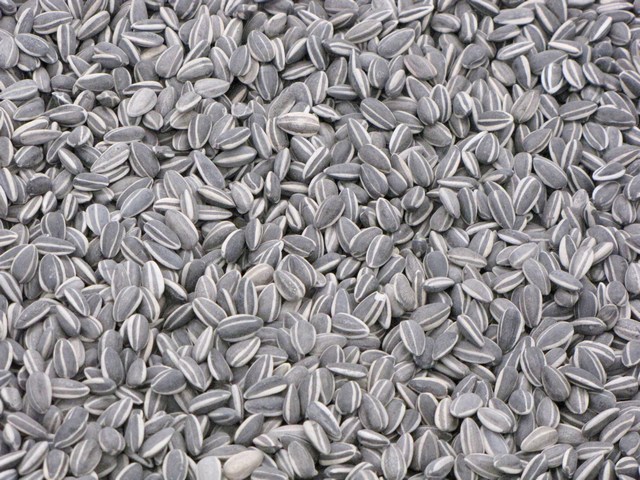
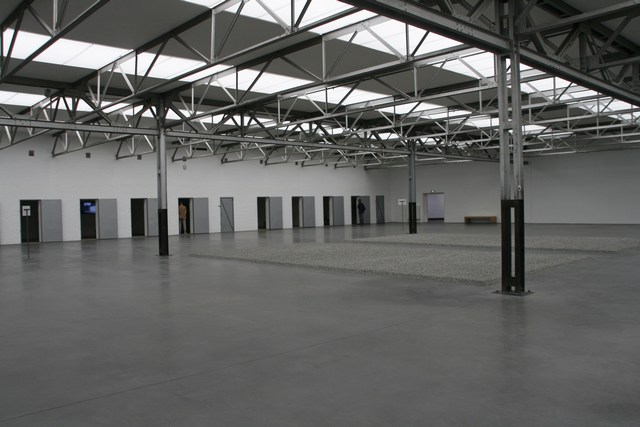
Tree #2 2011
hout/wood
Rocks 2009-2010
porselein/porcelain
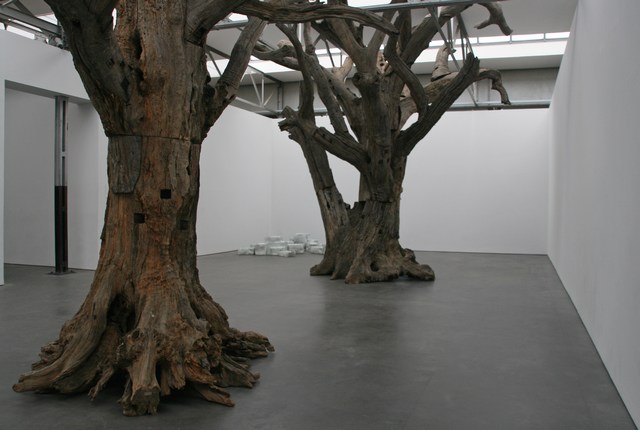
These porcelain and wooden sculptures were executed
using ancient handcraft traditions. The ceramic stones were made in
Jingdezhen, where Chinese porcelain production originates. The two tress
have been built from fallen trunks collected in the mountainous regions
of southern China. Similar to the construction of Ai Weiwei’s previous
wood sculptures, the tree fragments have been interlocked using a
classic Chinese technique.
Combining natural and crafted elements, the installation calls to mind a
traditional Chinese garden, a place to meditate. At the same time,
however, one may feel slightly disconcerted.
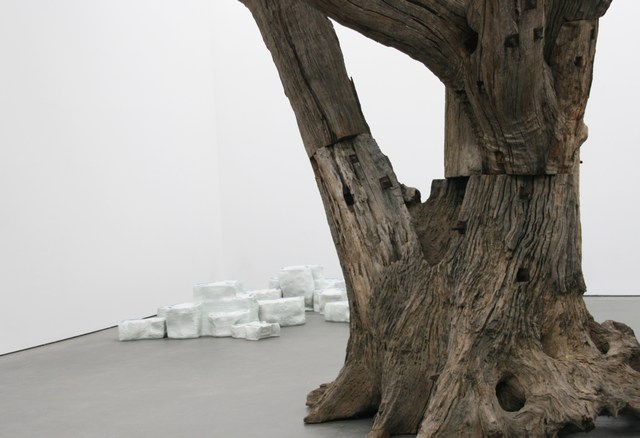
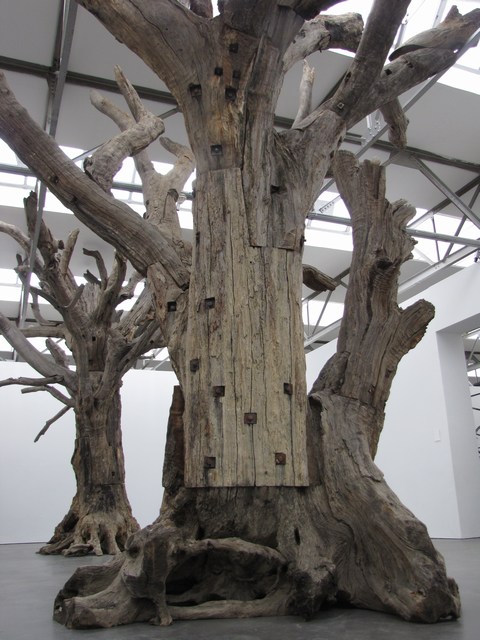
Fountain of Light 2005
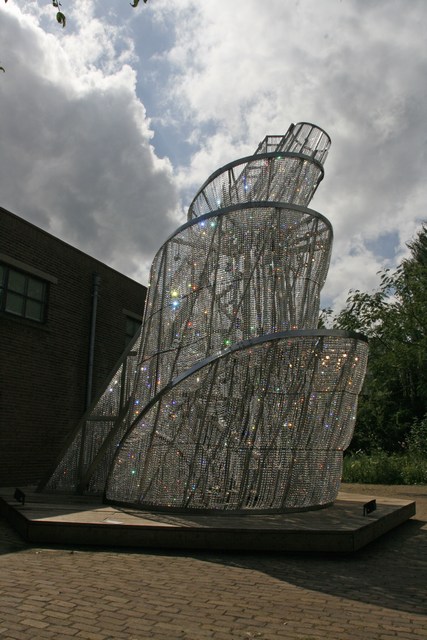
Fountain of Light is approximately 23 feet high and
was inspired by an ambitious monument to communism that was intended to
be built in Russia – but never was.
Vladimir Tatlin’s Monument to the Third International (1919) was to
embody the feats of an architecture that would match a new Utopian age.
If built it would have been higher than the Eiffel Tower in Paris.
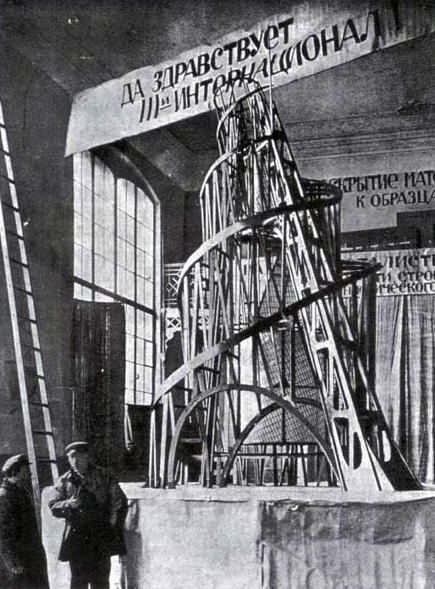
http://arkinetblog.wordpress.com/2010/03/11/monument-to-the-third-international-vladimir-tatlin/
Ai Weiwei’s smaller version can be seen as paying tribute to Tatlin.
However, he also transforms the old monument, ironically, into a
typically bourgeois accessory: the crystal chandelier.
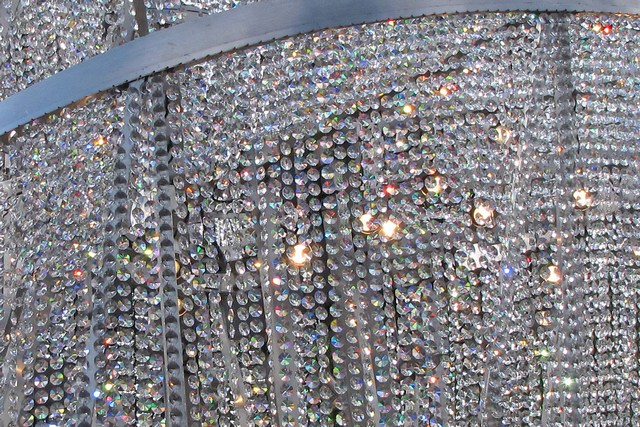
detail


Tatlin (l) and Ai Weiwei (r)

Mariko Mori lives and works in New York. Oneness is an allegory of connectedness, a representation of the disappearance of boundaries between the self and others. It is a symbol of the acceptance of otherness and a model for overcoming national and cultural borders. It also is a representation of the Buddhist concept of oneness, of the world existing as one interconnected organism.
Little
is known about the personal life of Mariko Mori. She is believed to been
born in Tokyo in to be married to the composer Ken Ideka.
The artist graduated from the Bunka Fashion College (Tokyo) in 1988 and
spent most of her teenage years working there as a fashion model. Later
that year, feeling restrained by the Japanese ethic of uniformity, she
moved to London attending the Byam Shaw School of Art (1988-89), and
Chelsea College of Art, London (1989-92). Since she studied on an
Independent Study Program at the Whitney Museum of American Art, New
York (1992-93), Mariko continues to work and live both there and in
Tokyo.
The avant-garde artist Mariko Mori combines pop art, self-portraits,
modern technology and Buddhist ideologies in her art. Post-modern
Cyberfeminism, futuristic images, you can get it all, visiting one of
her exhibitions.
In her early self-portraits (photos) she shows herself in the female
roles in her native Japan: the official lady, the schoolgirl, the
prostitute. She is not a “normal” woman, however, but she shows herself
as a cyborg, a kind of robot, mechanical and sexless. As we can’t escape
the advancement of technology we must embrace it and use it…
"We've
fallen into a fin-de-siecle period of crisis in which people believe
only the things they see right in front of them" - Mariko Mori -
The cyborgs are developing, they become less human. As Mariko makes
videos, we can watch the more alien-like cyborgs moving, dancing. The
titles of her works are pessimistic in tone. They are warning us of
mappo, the dark period of moral decline before the arrival of the
future Buddha. This moral decline is due to a mixture of consumerism and
advanced technology. Mariko is not only pessimistic, because she has an
answer. She combines technology with traditional Buddhist beliefs.
On the exhibition in Groningen there are four panoramic colour
photographs, called Esoteric Cosmos (1996-98), with the names
Entropy of Love, Burning Desire, Mirror of Water and Pure Land.
They symbolise the four elements of nature as defined by Buddhist
teaching. Mariko transforms human images in a strange landscape, a kind
of utopian world.
One of the examples of her videos you can watch is Miko no Inori.
Mariko is outfitted entirely in white, looking like an alien, caressing
a crystal ball in her hands. In the meanwhile Mariko’s voice can be
heard, singing.
A
very impressive
project of hers is the “Wave UFO”. Only recently has technology
advanced far enough to be able to realize this work of art. Now the
audience can utilise their own brain activity …
I think
all kinds of fantasy and dreams are very important to our life.
(Mariko interviewed by Blair 1995).
"
For a short impression, have a look at:
If this video has stopped,
you see small pictures at the bottom.
Click on these, for more impressions of the exhibition.